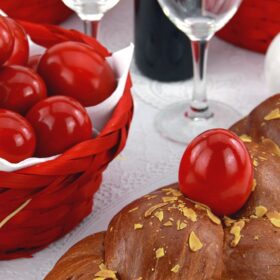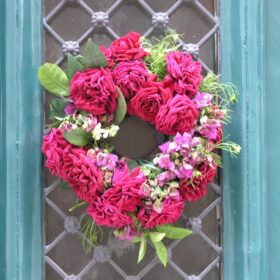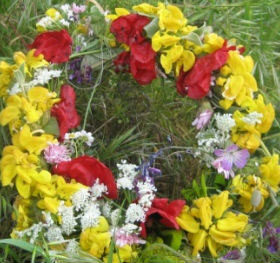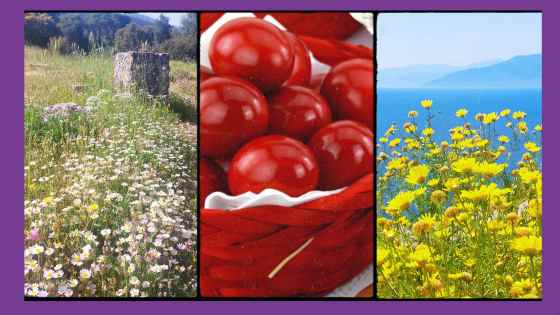Greece, Greek Culture
Greek Celebrations; Holy Easter Week and May 1st
It does not happen so often that Greek Easter celebrations and May 1st coincides during the same week, but it does this year!
The combination of a very religious Holy week, and the only non-religious public holiday of the year, makes it very interesting.
However, since Greeks love to celebrate, it would be a pity to have two celebrations at the same time.
So, do not worry, there is a solution for everything.
Since May 1st coincides with “megali tetarti” in the Holy week this year, this year the May Public Holiday of May 1st will be celebrated on May 7th, 2024
Below you can read more about those two major celebration in Greece, which makes it also a very nice period to travel to Greece.
Enjoying Greek Traditions: Holy Week Celebrations in Greece
In Greece, Holy Week, the week leading up to Easter Sunday (on May 5th 2024) , is a time of religious significance and cultural celebration.
Palm Sunday (28/4/24): Holy Week commences with Palm Sunday, known as “Kyriaki ton Vaion” in Greek.
On this day, churches across the country are adorned with palm leaves and olive branches, symbolizing the triumphal entry of Jesus into Jerusalem.
Holy Monday to Holy Wednesday: Throughout Holy Week, each day is dedicated to specific events in the life of Jesus Christ. Holy Monday, Holy Tuesday, and Holy Wednesday are marked by evening services focusing on the teachings of Jesus,
Holy Thursday – Μεγάλη Πέμπτη: Holy Thursday, or “Megali Pempti,” is a day of profound significance in the Orthodox Church. It commemorates the Last Supper of Jesus with his disciples, during which he instituted the sacrament of the Holy Eucharist. In the evening, churches hold the Service of the Holy Passion, reenacting the betrayal of Jesus.
Good Friday – Μεγάλη Παρασκεύη Good Friday, or “Megali Paraskevi,” is perhaps the most solemn day of Holy Week. It commemorates the crucifixion and death of Jesus Christ. Churches are draped in black, and processions take place, with worshippers carrying epitaphios (adorned with floral decorations) through the streets. The atmosphere is one of deep mourning and contemplation as believers reflect on the sacrifice of Christ for humanity.
Holy Saturday – Μεγάλο Σάββατο: Holy Saturday, or “Megalo Sabbato,” is a day of anticipation and preparation for the joyous celebration of Easter. In the evening, the Resurrection service, known as the “Anastasi,” takes place. It begins with the darkened church illuminated only by candles, symbolizing the darkness of the tomb. As the clock strikes midnight, the priest proclaims, “Christos Anesti” (Christ is Risen), and the congregation responds with “Alithos Anesti” (Truly He is Risen), ushering in the glorious resurrection of Jesus Christ.
Greek Easter – Κυριακή του Πάσχα: Easter Sunday or “Kyriaki tou Pascha,” is the most happy day of the week. Believers, but also non-believers, gather with family and friends to celebrate the resurrection of Jesus Christ from the dead, or just enjoy to be together with family and friends. The day begins with the traditional midnight Resurrection service (see above), eating the mayeritsa soup, and in the morning homes are filled with the aroma of festive dishes such as grilled lamb, kokoretsi, as well as tsoureki (sweet Easter bread), dyed red eggs, and so much more..

If you want to read a story, about how a non-Greek usually experiences his/her first Greek Easter, then take a look at this Podcast story in Greek.
Specially for the Easter days, now only at 3euro.
Easter Bazaar – Πασχαλινό Βαζααρ!
If you did not learn Greek yet, or you are just a Beginner learning Greek, do not worry!
You can enjoy Greek culture by listening to Greek music, traveling to Greece, socializing with locals, and following traditions
Interested in more eBooks about Greek culture and Greek language?
Then take a look at the special Easter bazaar 🙂
May 1st – Καλή Πρωτομαγιά!
It is a public holiday, and most shops remain closed.
Cafes and taverns are usually all open, and crowded
For many countries in Europe, May 1st is “International Labor Day” or “Workers Day”.
Times changed, and the younger generation maybe does not know anymore, but historically, it is a day that commemorates the struggles and victories of the labor movement,
honoring the achievements of workers and their contributions to society. It is a time for workers to gather, march in solidarity, and advocate for labor rights and fair treatment.
This tradition also exists in Greece, although for Greeks, this day is more commonly called “Protomagia” meaning the first day of May.
So, while marches take place around the country (mainly in the cities), those of a less political believes focus on those traditions related to the rebirth of nature, which have roots in ancient Greek customs.
The improving weather and starting of summer is celebrated, after the colder and dark days of winter.
So, May 1st is one of the few non-religious public holidays in Greece, celebrated with flowers, as well as the creation and exchange of flower wreaths.
Today, most Greeks will pick flowers, or also weave colorful wreaths that will decorate the doors of their homes, cars or the balconies of their city apartments.
Those flower wreaths, usually made of wildflowers, or called “stefania”, and is a tradition that has survived in all towns and villages across Greece.
Not sure what kind of wildflowers you can find in Greece?
Then take a look at the video below
Ancient Roots
The celebration of May 1st also has ancient roots, dating back to pre-Christian times when it was associated with the arrival of spring and the fertility rites of the goddess Chloris, the Greek goddess of flowers and spring In ancient Greek mythology,
Crafting Flower Wreaths
One of the most beloved customs associated with May 1st in Greece is the crafting of flower wreaths, known as “stefana” or “stefania.” These wreaths are intricately woven from an array of colorful flowers, herbs, and foliage, symbolizing the beauty and abundance of spring. Traditionally, young women and girls gather early in the morning to gather flowers from fields and gardens, carefully selecting blooms such as daisies, roses, and wildflowers.
Once the wreaths are crafted, they can be exchanged or friends, family members, and loved ones present each other with these floral crowns, accompanied by warm wishes for a joyful and prosperous year ahead.
May Day Festivities
Throughout Greece, May Day is celebrated with a variety of festivities, including outdoor concerts, folk dances, and communal feasts. Towns and villages come alive with music, gatherings, tavern meals, dancing..


Everywhere you look around, in cities, villages, archaeological sites, in the mountains, or next to the sea, you will see flowers.
Take a look at the video below, to get a better idea.



